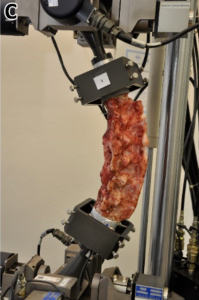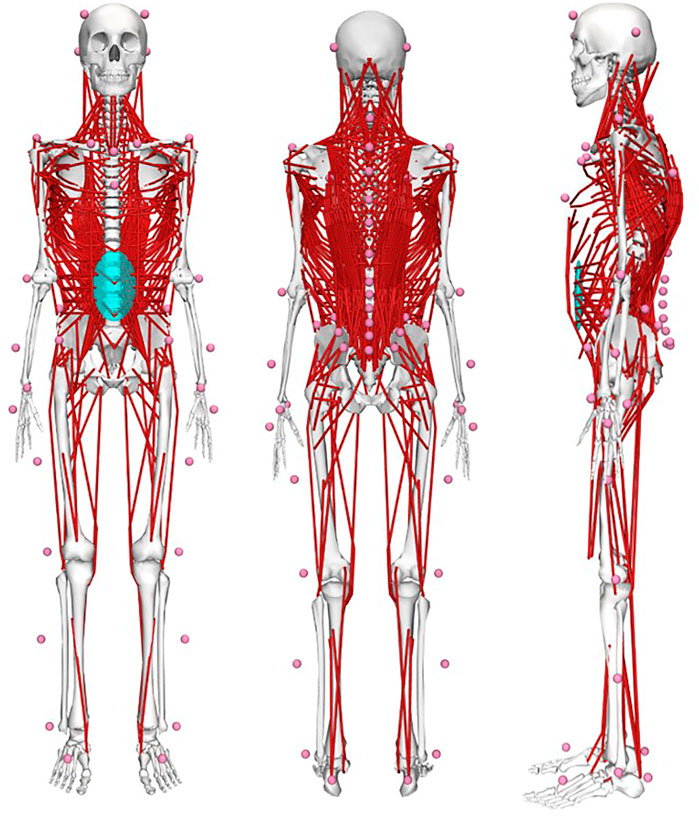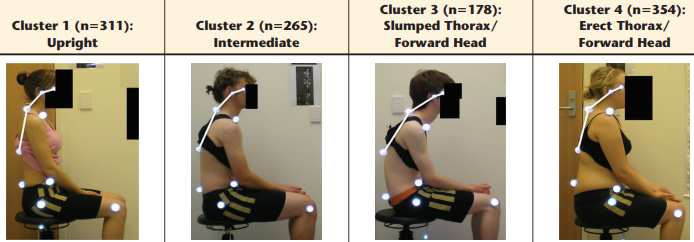There is no such thing as a “good” posture or a “bad” posture – at least not when it comes to back pain and back health. So, slouch back and relax while you read on – safe in the knowledge that you are not causing any harm to your back!
The idea that posture is not all that important will come as a surprise to most. Most people, and even most physiotherapists, still believe that there is such a thing as an “ideal” posture (1, 2). However, these beliefs are built on faulty foundations. Let’s explore how dead pigs’ spines, computer programmes and cultural beliefs have led us to this point – and how a better understanding of the body and pain may help to lead us to a brighter future.
The Virtue of “Good” Posture

Having “good” posture makes you a good person (or so some seem to believe…). Ancient Greek philosophers believed that “good” posture was “linked to the divinity and intelligence of human beings” (11). This idea seems to have stayed with us – with many people’s parents chastising them if they didn’t stand straight with their shoulders back.
To quote from a fantastic review written for the Australian Journal of General Practice, “Over the 17th and 18th centuries, ‘good’ posture came to signify health, strength and beauty. ‘Bad’ posture became an indicator of not only disability but also moral degeneration, commonly described in racial sciences in the early 20th century” (11).
Dead Pigs & Computer Programmes


The idea that posture is integral to health and injury has seeped into medical thought and practice. This has led to researchers studying the health benefits of ‘good’ posture over the years. The findings in summary – there are no strong links between posture and pain in day-to-day life. Let’s explore this further.
To study the integrity of the spine, some researchers have placed spines (removed from dead pigs) into specialised equipment and repeatedly bent, contorted and compressed them until something broke. What they found was that these spines tended to be a little bit more vulnerable when flexed repeatedly (literally thousands and thousands of times) with added compression forces (3). However, the differences were not all that massive, and remember, this was performed in the spines of dead pigs (as opposed to our living spines – capable of adapting to what life throws at them).
Other researchers have made complex models of the human body and run them through computer programmes to calculate the forces experienced at different points during a number of activities – including spinal movements. Despite this technical approach, researchers have reported differing findings with no agreement as to one “ideal” lifting posture (4, 5, 12).

Posture Does Not Predict Pain
If posture was an important factor in causing pain and injury, then you would think that those with “bad” posture would be more likely suffer from pain in the future, right? Many studies have failed to find links between posture and pain (6, 7) – suggesting that posture is not all that important here. A well run study of over 1,000 teenagers showed NO ASSOCIATION BETWEEN POSTURE AND NECK PAIN (see the image below) (13).
The researchers even followed up this group 5 years later to see if their posture was related to future pain issues. What they found was that the females who sat upright (leftmost image below) were MORE LIKELY to suffer from neck pain 5 years later than their slouching female friends (15).

Even the importance of lifting posture is being questioned – with evidence mounting to suggest that posture is not all that important in those who lift regularly at work (8, 9). More on this in a future blog post…
What has been found to be associated with posture from the research? Things like mood, exercise/ activity levels, BMI and occupational demands such as computer use (13, 14).
PERHAPS POSTURE IS MORE OF A SYMPTOM THAN A CAUSE – a symptom of the trials of life and not a cause of pain or health issues.
If Posture Doesn’t Matter – What Does?
Your Best Posture is Your Next Posture
We are all different. We stand, sit and move differently. The way you move will actually vary a lot at different times of the day.
Sitting or standing still for a period often becomes uncomfortable – this discomfort is a message from the body’s tissues telling you that they want some movement or a change of position. This movement is key to the health of the body and the tissues within it – helping to push and move nutrients around to the places they are needed, while disposing of waste products.
Bending, stretching, slouching, sitting up straight – all of these are normal and healthy positions to take up. Variability is normal and healthy.
Motion Is Lotion - Movement is Your Friend
Regular movement is important. In an earlier blog post we discussed how our we have inherited our ‘activity genes’ from our ancestors. Despite being very active, our ancestors would have sat and relaxed for many hours each day. They sat in a variety of positions and rarely for all that long – mostly in bouts of no more than 20 minutes (10).
While not a cure-all for back pain, regular physical activity and exercise seem to be important (13). Something that appears to be very useful in helping with back pain, particularly for those who have sedentary jobs driving or at desks, is “movement snacks” (i.e. regular movement throughout the day to break up periods of inactivity).
And no, just walking to the toilet doesn’t count – you have to try a little harder. For an excellent blog post on this, click HERE.
Other Factors that Actually Are Linked to Pain
Pain is complex and different for each individual. There are some factors that crop up again and again in the research that we can confidently say are associated with pain. These factors can be (16):
- Physical (exposure to excessive loading, prolonged sitting)
- Psychological (mood and emotions)
- Social (socioeconomic, cultural, work, home environment, and stress)
- Lifestyle (sleep, activity levels)
- Health (mental health, obesity)
- Nonmodifiable (genetics, sex, life stage)
Even severely negative childhood experiences (e.g. neglect, psychological abuse, etc) can increase the likelihood of someone suffering from pain and other health issues later in life (17).
There is so much to go into here, so we will explore this further in another blog post. But this gives a clue as to the complexity of pain and why the exact position you hold your back in may not be all that important. For anybody interested in learning a little bit more about pain, here is a great video.
When might posture be important
Posture is still relevant and important in some situations. It just does not seem important for those looking to reduce the pain they experience in day-to-day life.
Paralyses:
Those with a severe paralysis may need to sit in certain postures to prevent long-term issues related to organ compression.
In some acute injuries – but only temporarily:
Often after injury, certain movements hurt, while others feel better or relieving. Temporarily, it is usually a good idea to find positions that are comfortable while recovery takes place – easing back into the previously painful position as the issue resolves over time.
Some very high-level activities:
Some high-level athletics events demand that athletes move as effectively as possible and produce vast amounts of force. This is an example of where certain body and joint positions may be favorable for performance.
Also, lifting very heavy weights is probably best done in a relatively “neutral” position of the spine (this does not mean it has to be held dead straight – neutral seems to cover a range – here is a great blog post that goes into detail on this).
Others:
Some activities and sports actually rate performance on posture – such as many forms of dance. Also, when meeting your in-laws for the first time it’s probably a good idea not to slouch too much…
Why is all of this important to talk about?
Back pain is one of the leading causes of disability in the world. More and more money is being spent on scans and interventions, but this has not improved the situation.
Beliefs and behaviours are strongly associated with a person’s likelihood of suffering from pain, so improving our understanding in this area may help.
At the very least, it should help some people to avoid wasting money on practitioners using outdated treatments and industries that are profiting by offering “quick fixes” to those suffering from pain (while offering little to truly resolve the issue).
In Summary...
Sit however you like! Posture is not that important -> it seems to be more of a symptom of life than a cause of pain.
Your Best Posture is your Next Posture: Change position as you feel the need.
Motion is Lotion: It’s a bad idea to sit all day – best to break it into small chunks with regular, challenging movement breaks.
Pain is complex, more on this later…
Useful Resources:
Recommended Podcasts:
Podcast about Posture and Pain: Empowered Beyond Pain Episode 16a: Posture and Pain: Low back pain fact 6 with Diane Slater and Dr Kieran O’Sullivan PhD
Podcast about Lifting Posture: Empowered Beyond Pain Episode 16b: Posture and Pain: Low back pain fact 6 with patient voice Joe, and Nic Saraceni
Recommended Blog Posts:
15 Minute Read: Microbreaking Blog Post by Paul Ingraham of PainScience.com
100 minute read (for the hardcore posture folk out there): Does Posture Matter? by Paul Ingraham of PainScience.com
References:
- Korakakis V, O’Sullivan K, O’Sullivan PB, et al. Physiotherapist perceptions of optimal sitting and standing posture. Musculoskelet Sci Pract 2019;39:24–31. doi: 10.1016/j.msksp.2018.11.004
- Korakakis V, O’Sullivan K, Whiteley R, et al. Notions of ‘optimal’ posture are loaded with meaning. Perceptions of sitting posture among asymptomatic members of the community. Musculoskelet Sci Pract 2021;51:102310. doi: 10.1016/j.msksp.2020.102310.
- Callaghan, J.P. and McGill, S.M., 2001. Intervertebral disc herniation: studies on a porcine model exposed to highly repetitive flexion/extension motion with compressive force. Clinical biomechanics, 16(1), pp.28-37.
- Potvin, J.R., McGill, S.M. and Norman, R.W., 1991. Trunk muscle and lumbar ligament contributions to dynamic lifts with varying degrees of trunk flexion. Spine, 16(9), pp.1099-1107.
- Kingma, I., Faber, G.S. and Van Dieën, J.H., 2010. How to lift a box that is too large to fit between the knees. Ergonomics, 53(10), pp.1228-1238.
- No consensus on causality of spine postures or physical exposure and low back pain: A systematic review of systematic reviews
- Laird, R.A., Gilbert, J., Kent, P. and Keating, J.L., 2014. Comparing lumbo-pelvic kinematics in people with and without back pain: a systematic review and meta-analysis. BMC musculoskeletal disorders, 15(1), pp.1-13.
- Saraceni, N., Campbell, A., Kent, P., Ng, L., Straker, L. and O’Sullivan, P., 2021. Exploring lumbar and lower limb kinematics and kinetics for evidence that lifting technique is associated with LBP. PLoS One, 16(7), p.e0254241.
- Saraceni, N., Kent, P., Ng, L., Campbell, A., Straker, L. and O’Sullivan, P., 2020. To flex or not to flex? Is there a relationship between lumbar spine flexion during lifting and low back pain? A systematic review with meta-analysis. Journal of Orthopaedic & Sports Physical Therapy, 50(3), pp.121-130.
- Lieberman, D., 2020. Exercised: The science of physical activity, rest and health. Penguin UK.
- Smythe, A. and Jivanjee, M., 2021. The straight and narrow of posture: Current clinical concepts. Australian journal of general practice, 50(11), pp.807-810.
- von Arx, M., Liechti, M., Connolly, L., Bangerter, C., Meier, M.L. and Schmid, S., 2021. From stoop to squat: A comprehensive analysis of lumbar loading among different lifting styles. Frontiers in bioengineering and biotechnology, 9, p.1070.
- Richards, K.V., Beales, D.J., Smith, A.J., O’Sullivan, P.B. and Straker, L.M., 2016. Neck posture clusters and their association with biopsychosocial factors and neck pain in Australian adolescents. Physical Therapy, 96(10), pp.1576-1587.
- Côté, P., van der Velde, G., Cassidy, J.D., Carroll, L.J., Hogg-Johnson, S., Holm, L.W., Carragee, E.J., Haldeman, S., Nordin, M., Hurwitz, E.L. and Guzman, J., 2009. The burden and determinants of neck pain in workers: results of the Bone and Joint Decade 2000–2010 Task Force on Neck Pain and Its Associated Disorders. Journal of manipulative and physiological therapeutics, 32(2), pp.S70-S86.
- Richards, K.V., Beales, D.J., Smith, A.L., O’Sullivan, P.B. and Straker, L.M., 2021. Is neck posture subgroup in late adolescence a risk factor for persistent neck pain in young adults? A prospective study. Physical therapy, 101(3), p.pzab007.
- O’Sullivan, P., Caneiro, J.P., O’Keeffe, M. and O’Sullivan, K., 2016. Unraveling the complexity of low back pain. Journal of Orthopaedic & Sports Physical Therapy, 46(11), pp.932-937.
- Hanlon, P., McCallum, M., Jani, B.D., McQueenie, R., Lee, D. and Mair, F.S., 2020. Association between childhood maltreatment and the prevalence and complexity of multimorbidity: A cross-sectional analysis of 157,357 UK Biobank participants. Journal of comorbidity, 10, p.2235042X10944344.


Pingback: Pain: What Really Matters -